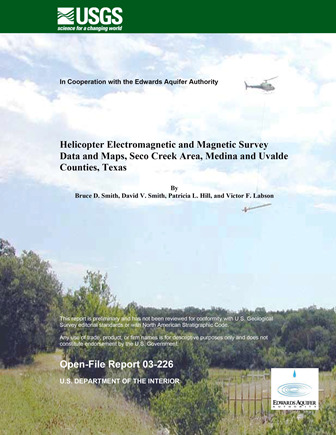Helicopter Electromagnetic and Magnetic Survey Data and Maps, Seco Creek Area, Medina and Uvalde Counties, Texas

| Author | Smith BD, Cain MJ, Clark AK, Moore DW, Faith JR and Hill PL |
| Year | 2003 |
| Description | Helicopter survey of electromagnetic and magnetic properties with hydrologic application around the Valdina Farms sinkhole in Medina County, Texas |
| Report Number | USGS O-FR 2003-226 |
| Publisher | US Geological Survey |
| Location | Medina County, Uvalde County |
| Cover | View Download |
| File | View Download |
| Summary |
|
The purpose of this study was to obtain an airborne electromagnetic survey of northern Medina County in the vicinity of the Seco Creek Sinkhole. The data indicated that the survey is effective to a depth of approximately 100 meters below grade and that the data shows more detailed geologic structure than previously prepared geologic maps. Geologic structure and their effects on groundwater flow can be interpreted from the data. The study was completed in July 2003 by the United States Geological Survey, Denver, Colorado. A helicopter electromagnetic and magnetic (HEM) survey was completed of a 209 square kilometer (81 square miles) area of the central Edwards aquifer. This openfile report is a release of the airborne geophysical data and a summary of the hydrologic application. The survey area was centered on the Valdina Farms sinkhole along the Seco Creek drainage in western Medina County, Texas. Flight lines were flown north south with three east west tie lines to aid in leveling the magnetic data. Additional lines were flown on each side of the Seco and Little Seco Creek drainages. A five kilometer (4 mile) extension of 15 lines was flown north of the main survey block centered on Seco Creek. This digital data release contains the flight line data, grids, and maps of the HEM survey data. The Edwards aquifer in this area consists of three hydrologic zones: catchment, recharge, and confined. The Glen Rose Formation is exposed in the catchment area. The recharge zone is situated in the Balcones fault zone where the Devils River Group of the Edwards aquifer has been exposed by normal faults. The magnetic data is not discussed in depth here, but does have high amplitude closed anomalies caused by shallow igneous intrusives. The Woodard Cave Fault that separates the recharge and catchment zones is in places associated with a weak linear magnetic low. The HEM data has been processed to produce apparent resistivities for each of the six EM coil pairs and frequencies. Maps of the apparent resistivity for the five horizontal coil pairs show that the catchment, recharge, and confined zones all have numerous linear features that are likely caused by structures, many of which have not been mapped. The distribution of high resistivity areas reflects the lithologic differences within the Trinity and Edwards aquifers. |
Search for Documents
Advance Search
Explore EAA's Scientific Reports
- All Reports
- Weather Modification
- Geology
- Water Use and Conservation
- Geochemistry
- Water Resources Planning and Management
- Floods and Drought
- Water Quality
- Climatology
- Surface Water / Groundwater Relationship
- Biology
- Springs, Groundwater Discharge
- Archaeology
- RZ Protection
- Aquifer Levels
- Remote Sensing
- Precipitation
- Overview Studies
- Modeling
- Hydrology and Hydrogeology
- History
- Groundwater Recharge, Recharge Zone
- Groundwater Movement
- Geomorphology and Caves
